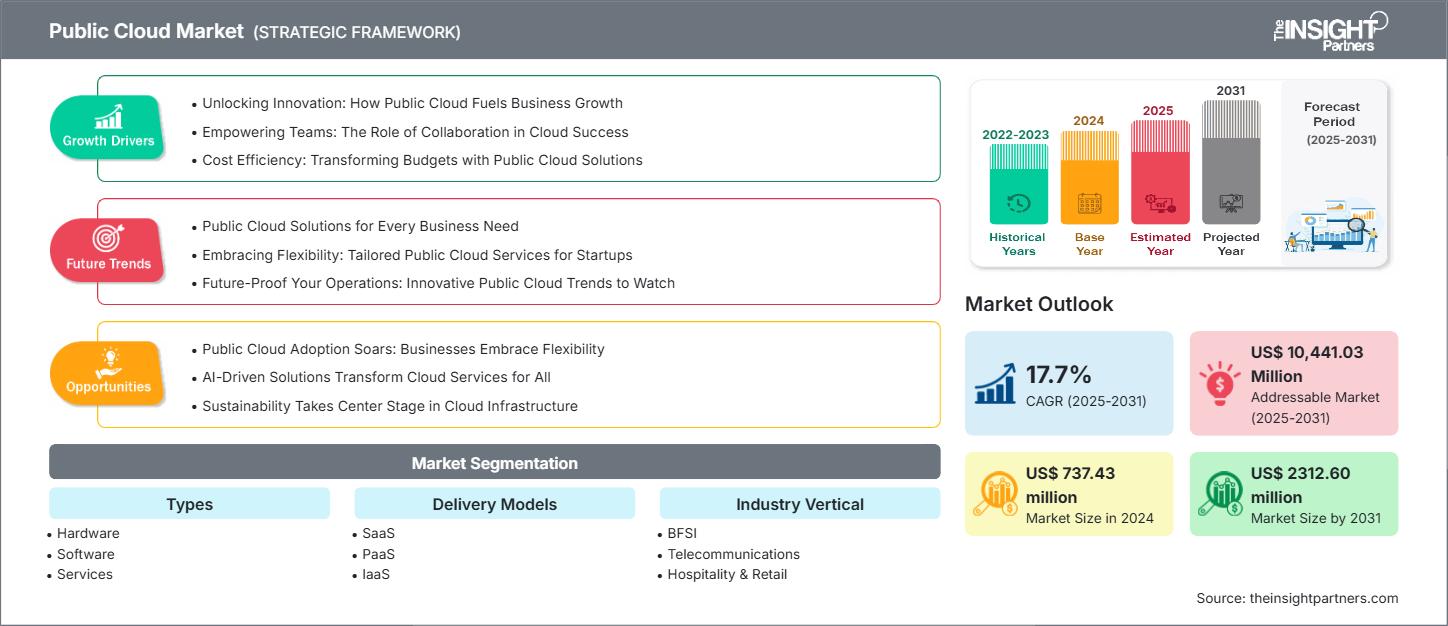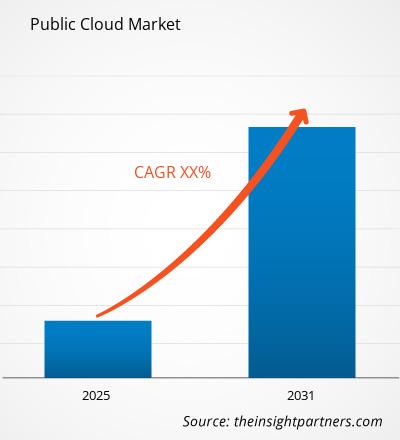Le marché du cloud public devrait atteindre 684,47 milliards de dollars américains d'ici 2031. Ce marché devrait enregistrer un TCAC de 14,8 % entre 2025 et 2031.
Les services cloud servent de plateforme de stockage pour les données des organisations, à des fins diverses. Ces données sont ensuite extraites pour analyse. Le cloud public désigne les services cloud proposés via un réseau public et accessibles à distance. Le principal avantage du modèle de cloud public réside dans la limitation des préoccupations liées au stockage et à la maintenance des données. L'infrastructure est externalisée et l'architecture mutualisée permet à plusieurs organisations de partager l'espace de calcul du fournisseur tiers. Les PME bénéficient particulièrement de l'externalisation du stockage et de la maintenance de leurs données auprès de fournisseurs cloud tiers, réalisant ainsi d'importantes économies sur les investissements initiaux liés à la mise en place d'une infrastructure. La réduction des coûts, la rapidité de développement et de test, ainsi que la diminution du délai de commercialisation des produits ont incité de nombreuses entreprises de divers secteurs à adopter la technologie du cloud public.
Vous bénéficierez d'une personnalisation gratuite de tous les rapports, y compris certaines parties de ce rapport, l'analyse par pays, le pack de données Excel, et vous profiterez également d'offres et de réductions exceptionnelles pour les start-ups et les universités.
Marché du cloud public : Perspectives stratégiques

- Découvrez les principales tendances du marché présentées dans ce rapport.Cet échantillon GRATUIT comprendra une analyse de données, allant des tendances du marché aux estimations et prévisions.
Au cours de la dernière décennie, l'industrie du logiciel a connu des transformations majeures. Le déploiement de modèles cloud par les entreprises figure parmi les plus importantes, grâce aux nombreux avantages qu'il offre. La forte évolutivité des entreprises les incite à opter pour les services cloud, car la capacité de stockage des données peut être ajustée en fonction des besoins des utilisateurs. De plus, la tarification des fournisseurs de cloud public est généralement basée sur le principe du paiement à l'usage. Les entreprises, notamment les PME, n'ont pas à investir des sommes importantes en une seule fois, ce qui rend le déploiement du cloud public particulièrement attractif pour leurs opérations. Leurs compétences clés sont ainsi préservées, leur permettant de rester compétitives sur ce marché très dynamique. La réduction des coûts opérationnels et la multitude de solutions métiers spécifiques proposées par un fournisseur unique sont les principaux moteurs du marché des services de cloud public. Le besoin d'une infrastructure informatique évolutive, flexible, simple et efficace contribue également de manière significative à la croissance de ce marché. La minimisation des erreurs humaines, grâce à l'automatisation complète des opérations, encourage les entreprises à adopter les services de cloud public. Les facteurs mentionnés ci-dessus expliquent l'adoption exponentielle de ce marché. Malgré une adoption importante dans les pays développés, la croissance des services de cloud public a rencontré quelques obstacles. Les préoccupations liées à la sécurité et à la confidentialité des données constituent le principal frein à ce marché. Les exigences élevées en matière de connectivité Internet pour ce modèle de cloud, notamment dans les pays où la connectivité est faible, impacteront la mise en œuvre du cloud public. L'intégration de ce modèle aux systèmes existants représente également un frein. Parmi les autres contraintes figurent les pannes et la mobilité des données.
Aperçu régional du marché du cloud public
Les analystes de The Insight Partners ont analysé en détail les tendances régionales et les facteurs influençant le marché du cloud public tout au long de la période prévisionnelle. Cette section aborde également les segments de marché et la répartition géographique du cloud public en Amérique du Nord, en Europe, en Asie-Pacifique, au Moyen-Orient et en Afrique, ainsi qu'en Amérique du Sud et centrale.
Portée du rapport sur le marché du cloud public
| Attribut du rapport | Détails |
|---|---|
| Taille du marché en 2024 | XX milliards de dollars américains |
| Taille du marché d'ici 2031 | 684,47 milliards de dollars américains |
| TCAC mondial (2025 - 2031)CAGR (2025 - 2031) | 14,8% |
| Données historiques | 2021-2023 |
| Période de prévision | 2025-2031 |
| Segments couverts | Par types
|
| Régions et pays couverts | Amérique du Nord
|
| Leaders du marché et profils d'entreprises clés |
|
Densité des acteurs du marché du cloud public : comprendre son impact sur la dynamique des entreprises
Le marché du cloud public connaît une croissance rapide, portée par une demande croissante des utilisateurs finaux. Cette demande est alimentée par l'évolution des préférences des consommateurs, les progrès technologiques et une meilleure connaissance des avantages du produit. Face à cette demande grandissante, les entreprises élargissent leur offre, innovent pour répondre aux besoins des consommateurs et tirent parti des tendances émergentes, ce qui stimule davantage la croissance du marché.

- Découvrez un aperçu des principaux acteurs du marché du cloud public
Le marché mondial du cloud public est segmenté par type (matériel, logiciel et services) et par modèle de déploiement (SaaS, PaaS et IaaS). Il est également segmenté selon les utilisateurs finaux : PME et grandes entreprises. La segmentation s'effectue aussi par secteur d'activité : banque, finance et assurance (BFSI), télécommunications, hôtellerie et distribution, secteur public, industrie et santé. L'Amérique du Nord domine le marché mondial du cloud public grâce à ses avancées technologiques remarquables et à son développement socio-économique. L'Europe, autre pôle industriel majeur, contribue également à la croissance de ce marché. La région nordique, avec ses nombreuses PME, représente une part importante du marché européen. Enfin, la région Asie-Pacifique rattrape progressivement son retard, notamment grâce aux investissements croissants de pays en développement comme l'Inde et la Chine dans les technologies du cloud public. Parmi les principaux acteurs du marché mondial du cloud public figurent Microsoft Corporation, Salesforce.com, Cisco Systems, Inc., VMWare, Google, Inc., Oracle Corporation et Eucalyptus, entre autres.
- Analyse historique (2 ans), année de base, prévision (7 ans) avec TCAC
- Analyse PEST et SWOT
- Taille du marché Valeur / Volume - Mondial, Régional, Pays
- Industrie et paysage concurrentiel
- Ensemble de données Excel
Rapports récents
Témoignages
Raison d'acheter
- Prise de décision éclairée
- Compréhension de la dynamique du marché
- Analyse concurrentielle
- Connaissances clients
- Prévisions de marché
- Atténuation des risques
- Planification stratégique
- Justification des investissements
- Identification des marchés émergents
- Amélioration des stratégies marketing
- Amélioration de l'efficacité opérationnelle
- Alignement sur les tendances réglementaires




















 Obtenez un échantillon gratuit pour - Marché du cloud public
Obtenez un échantillon gratuit pour - Marché du cloud public